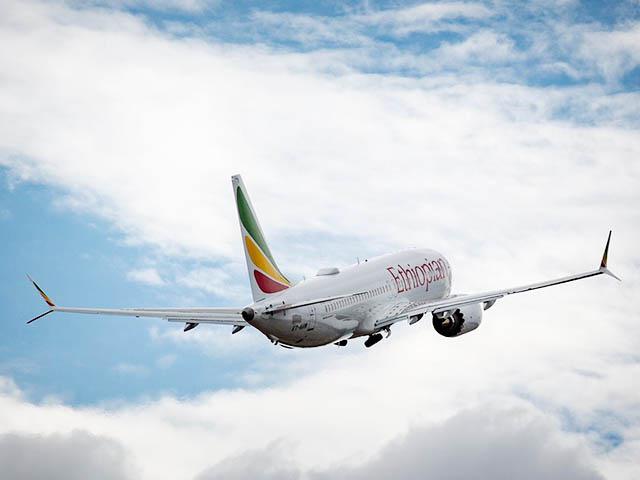By akademiotoelektronik, 08/02/2022
Ethiopian Airlines crash: a preliminary report without surprise
The preliminary report on the Ethiopian Airlines crash last month on Thursday confirmed information leaked the previous days: the pilots followed procedures by disabling the MCAS system, but were unable to regain control of the 737 MAX. Boeing has acknowledged the similarities with the Lion Air accident, but insists on the "intrinsic safety" of its re-engined single-aisle.
This report presented on April 4, 2019 by the Ethiopian Air Accident Investigation Board (AAIB) on the accident of flight ET302 on March 10, which caused 157 victims, is mainly based on information from the flight data recorder ( FDR). It confirms that the 737 MAX 8 registered ET-AVJ had a valid certificate of airworthiness at the time of the accident, the pilots had the required qualifications and the necessary authorizations to fly the aircraft, the take-off procedures were nominal and the pilots followed the procedures. AAIB Director Amdiye Ayalew said writing the full report is expected to take "between six months and a year" as the search for other issues that may have affected the aircraft continues. “The crew repeatedly carried out all the procedures provided by the manufacturer, but they were unable to regain control of the aircraft,” Ethiopian Transport Minister Dagmawit Moges said; she clarified that the main objective of the investigation was not to “blame” anyone and defended its independence, saying that there was no “interference” to be deplored. But she asked Boeing that "the aircraft's flight management system be reviewed", without mentioning the MCAS anti-stall system implicated in the two accidents which killed 346 people in five months.
Ethiopian Airlines captain Yared Getachew had 103 flight hours aboard the brand new 737 MAX 8, one of four the airline put into service (out of a total of 8,200 hours including 1,400 on 737), while that the co-pilot had 56; they had followed their last simulator sessions at the end of September and the beginning of December 2018 respectively. If they initially followed the procedures by deactivating the MCAS, the preliminary report does not explain why the plane did not respond to the pilot's actions, including the last two "pull up" commands about 30 seconds before the aircraft crashed. Nor if the crew actually reactivated the MCAS (contrary to Boeing's instructions) 3 minutes after having deactivated it, the aircraft then responding to an automatic “nose down” command; nor why the thrust of the engines seemed abnormally high.

The report, on the other hand, specifies that the angle of attack (AOA) sensors functioned correctly during taxiing, before sending contrary signals six seconds after takeoff – which suggests a bird strike or debris having damaged that of left, connected to MCAS. The left stick shaker then kicked in and remained active almost to the end of the flight. Despite divergent indications from the probes, the crew continued the climb, engaging the autopilot at about 1000 feet. The co-pilot began to retract the flaps; just over 30 seconds after activation, the autopilot disengaged, and the captain reported that the aircraft was experiencing control problems. Eight minutes after takeoff, the aircraft hit the ground at a speed of 500 knots according to the right probe, and 458 knots according to the left probe.
Ethiopian Airlines reacted to this preliminary report, defending its pilots; CEO Teweolde Gebremariam said he was "very proud that they followed the emergency procedures and their high degree of professionalism in extremely difficult conditions", acknowledging the Ethiopian Airlines Academy and its training center of pilots. His counterpart at Boeing Commercial Aviation, Kevin McAlliser, for his part published a long press release in which he acknowledged that the angle of attack data transmitted to the aircraft by the angle of attack sensor were erroneous, "causing the activation automated aircraft attitude control system MCAS during flight, as was the case during Lion Air flight JT610". “So that the involuntary activation of the MCAS system does not happen again”, the leader recalls that Boeing “has developed and plans to implement” an update of the MCAS software, as well as a complete training program along with additional training for 737 MAX pilots: this update “brings new layers of protection and will prevent MCAS from being activated by erroneous data. Pilots will still have the option to override MCAS and manually take control of the aircraft.” When the MAX returns to the air, “it will be the safest plane that has ever flown,” added Boeing, which posted a photo of its CEO Dennis Muilenburg sitting in the cockpit of a 737 MAX during a test flight. .
The detailed sequence of flight ET302 is available here (in English, with link to the preliminary report).
365 days a year, Air-Journal informs you for free. Support the site with a donation, participate in its development!I make a donationPrint the article
Related Articles